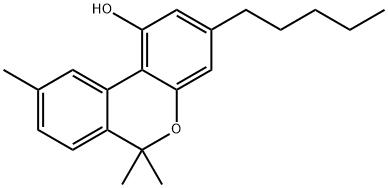CANNABINOL
- CAS No.
- 521-35-7
- Chemical Name:
- CANNABINOL
- Synonyms
- CBN;CANNABINOL;NSC 134455;Cannabinol (CRM);cannabinol solution;cannabinolmethanolsolution;Methanol(test Cannabinol, 1.0 mg/mL);Cannabinol (CBN) 1000 ug/mL in Methanol;CANNABINOL CRYSTALLINE--DEA SCHEDULE I I;cannabinol crystalline--dea*schedule I item
- CBNumber:
- CB5764514
- Molecular Formula:
- C21H26O2
- Molecular Weight:
- 310.43
- MDL Number:
- MFCD00056774
- MOL File:
- 521-35-7.mol
| Melting point | 76-77° |
|---|---|
| Boiling point | bp0.05 185° |
| Density | 1.0865 (rough estimate) |
| refractive index | 1.4900 (estimate) |
| Flash point | 11 °C |
| storage temp. | 2-8°C |
| pka | 9.40±0.40(Predicted) |
| Stability | Stable. Combustible. Incompatible with strong oxidizing agents. |
| FDA UNII | 7UYP6MC9GH |
| NCI Drug Dictionary | cannabinol |
| EPA Substance Registry System | Cannabinol (521-35-7) |
| UNSPSC Code | 41116107 |
| NACRES | NA.24 |
SAFETY
Risk and Safety Statements
| Symbol(GHS) |    GHS02,GHS06,GHS08 |
|||||||||
|---|---|---|---|---|---|---|---|---|---|---|
| Signal word | Danger | |||||||||
| Hazard statements | H225-H301-H311-H331-H370-H301+H311+H331 | |||||||||
| Precautionary statements | P210-P260-P280-P301+P310-P311 | |||||||||
| Hazard Codes | F,T | |||||||||
| Risk Statements | 11-23/24/25-39/23/24/25 | |||||||||
| Safety Statements | 7-16-36/37-45 | |||||||||
| RIDADR | UN 1230 3/PG 2 | |||||||||
| WGK Germany | 1 | |||||||||
| RTECS | HP8575000 | |||||||||
| NFPA 704 |
|
CANNABINOL Chemical Properties,Uses,Production
Chemical Properties
thin platelets
Uses
A metabolite of Tetrahydrocannabinol (T293200). A psychoactive substance cannabinoid that acts as a weak agonist of the CB1 and CB2 receptors.
Definition
ChEBI: Cannabinol is a dibenzopyran.
General Description
Leaflets.
Reactivity Profile
CANNABINOL is an alcohol. Flammable and/or toxic gases are generated by the combination of alcohols with alkali metals, nitrides, and strong reducing agents. They react with oxoacids and carboxylic acids to form esters plus water. Oxidizing agents convert them to aldehydes or ketones. Alcohols exhibit both weak acid and weak base behavior. They may initiate the polymerization of isocyanates and epoxides.
Fire Hazard
Flash point data for CANNABINOL are not available, but CANNABINOL is probably combustible.
Biological Activity
CB 1 and CB 1 receptor agonist (K i values are 126 and 211 nM respectively). Inhibits adenylyl cyclase (EC 50 values are 120 and 261 nM for CB 1 and CB 2 receptors respectively) and suppresses immune cell function. Major constituent of cannabis; displays little or no psychotropic activity.
Purification Methods
Cannabinol crystallises from pet ether and sublimes in a vacuum. [Meitzer et al. Synthesis 985 1981, Beilstein 17 II 151, 17 III/IV 1652.]
CANNABINOL Preparation Products And Raw materials
Raw materials
Preparation Products
521-35-7(CANNABINOL)Related Search:
1of4





